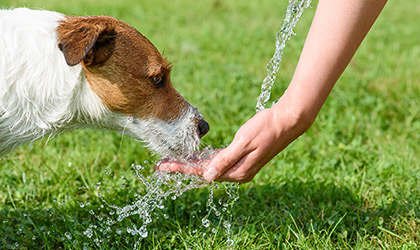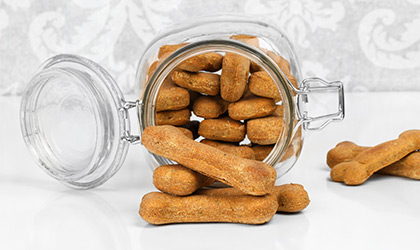
The prospect of dealing with an injured or sick pet can fill us with pure dread. It doesn’t bear thinking about, really. But our furry friends do find themselves in the wars at times – that’s just a fact of animal life. So, one of the best things you can do as a responsible owner is prepare for every eventuality and become first aid savvy. Not surrendering to panic is the golden rule when faced with an emergency. If you remain calm and relaxed, it will be much easier to deal with the situation at hand. The quicker you respond, the quicker your pet should recover, simple.
Wounds and bleeding
If your beloved companion has a puncture, cut or bite – anything more than just a surface graze – he will need to see a vet for stitching. Before moving him though, there are some important measures you need to take at home. Stopping the bleeding – or reducing it as much as possible – is numero uno. If possible, elevate the affected area above the heart, and apply some pressure with a clean wound dressing (you can find this in any first aid kit), or some old clothing. Although keeping the area infection-free is key, minimising the loss of blood takes precedence, so focus most of your attention on that. Once your poorly pet is safe to move, only then should you transport him to the vets. Be mindful that your furry friend will probably be in shock too; try comforting him with a soothing, reassuring voice. Above all, remain calm – you don’t want to elevate your pet’s already sky-high stress levels.
Burns and scalds
Time is of the essence when treating burns and scalds. As soon as you notice your pet has burned himself, run cold water over the affected area for five minutes, and then call the vet. Don’t be tempted to apply creams or ointments at this point. If, however, you know there’s going to be a delay, place a saline-soaked dressing over the burn. Be sure to keep your little fur ball warm too.
Sprains and breaks
Unfortunately, there isn’t much you can do if you notice your pet has a dislocated or broken limb. These cases are for your vet, so seek assistance as soon as possible. Such accidents will be extremely painful for your four-pawed friend; avoid touching the area since animals can lash out if they’re in pain. The best thing you can do is minimise movement by securing your dog on a lead or keeping your cat in a carrier until you arrive at the vets.
Breathing and cardiac problems
After an accident, injury or even as a result of shock, it’s not uncommon for your pet’s heart to stop beating. If this happens, you need to perform a heart massage and artificial respiration immediately. It’s natural to feel a little hesitant about this procedure, but it could save your companion’s life.
To perform a heart massage, place the heel of your hand on the left-hand side of your companion’s chest, just behind his elbow. Place your other hand on top and apply pressure, although this shouldn’t be too hard. Understandably, the pressure needed will vary from pet to pet; smaller dogs and cats won’t require as much force as their larger canine counterparts. For smaller animals, you will need to use your fingers to perform the cardiac massage.
To deliver artificial respiration, lay your pet on his side, stretching out his neck as much possible. Open his mouth; pull his tongue forward and check for any obstructions like blood. Then, holding his mouth closed, breathe into his nostrils for approximately two to three seconds. You should notice his lungs inflate as you do this. If his lungs fail to inflate, then his head isn’t positioned correctly and the air is escaping from his mouth. To kick-start your pet’s heartbeat, perform six chest compressions (one per second), and then one artificial respiratory breath. Repeat the entire procedure until your companion begins breathing unaided, or until your vet gives you the all clear.
Poisoning
Pets are inquisitive creatures – and don’t we know it. But their curiosity and often-insatiable appetites can result in them consuming potentially harmful substances. Plants, medication, certain foods – you name it, many things can prove toxic to our pets. The early stages of poisoning include excessive saliva, digestive upsets, irritability, acute vomiting and nausea. As it worsens, toxicity can lead to a racing heartbeat, coughing up blood and even seizures. If you notice any of these symptoms and suspect your pet has been poisoned, find the packaging of the substance swallowed and call your vet immediately. Don’t feed your pet, induce vomiting or do anything else without the direction of your vet.
Seizures
While it’s tempting to comfort and hold down an animal having a seizure, you should refrain from doing this – such pressure actually provides stimulation and may exacerbate the seizure. What you can do, however, is darken the room, reduce noise, keep any potential hazards away from the pet (electrical items, for instance), and ensure the room is padded with cushions. You should call your vet at this point too.
Insect stings
The darting and whizzing of insects can entertain cats and dogs for hours. But when your furry friend gets a little too close for comfort with these critters, they can get stung (surprise, surprise). If this happens, remove the sting from the poison sac, and bathe the affected area with a mixture of bicarbonate of soda or ice. If your pet is stung on the throat or mouth, contact the vet as soon as possible because this can cause swelling and then difficulty breathing.
Key points to remember
-
In the event of a medical emergency, contact your vet immediately. Keep your vet’s contact details in a couple of easy-to-find spots – in your phone, pinned to your fridge, or in your diary.
-
When you speak to your vet, have a pen handy just in case they give you another number or any important instructions.
-
Remember, it’s just as vital to keep yourself safe. You can’t support your pet if you get injured trying to assist him. Make sure you approach the situation as sensibly as possible.
-
Be mindful that injured pets can become defensive. Even the most sweet-natured, docile animals can lash out if they’re in pain. To protect yourself, consider restraining felines by putting a thick towel over their heads, and muzzling your mutts. If you do get bitten, consult your doctor.
-
Never be tempted to give your little fur ball human medication. This could only make matters worse.
-
Don’t offer food or drink to your pet in case they need an anaesthetic.
-
Always drive carefully when transporting your furry friend to the vets.
Take home message
Many of us hope and pray that we never have to encounter a sick or injured pet. But, sadly, this is a reality some of us can’t avoid. The good news is that by refining your first aid knowledge, you can alleviate the severity of most medical emergencies from your home. According to the American Animal Hospital Association, one in four pets would survive a medical emergency, if just one first aid technique were used before getting to a vet. Understandably then, it’s well worth your efforts. Remember, when your pet is in trouble, always remain calm and relaxed. Not only will this help you deal with situation faster, but it will also reassure your furry friend.
References:
-
Blue Cross. (2018). Basic first aid for dogs. Available online: https://www.bluecross.org.uk/pet-advice/basic-first-aid-dogs
-
Cats Protection. (2018). Cat first aid. Available online: https://www.cats.org.uk/help-and-advice/cat-first-aid
-
Pets 4 Homes. (2018). First aid for pets. Available online: https://www.pets4homes.co.uk/pet-advice/first-aid-for-pets.html
-
First Aid For Dogs. (2018). Why learn first aid for dogs? Available online: http://www.firstaidfordogs.co.uk/news/why-learn-canine-first-aid



